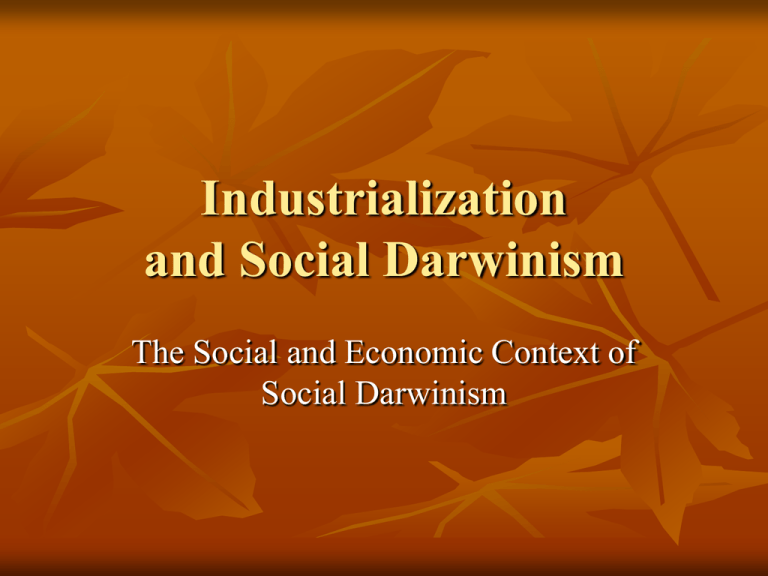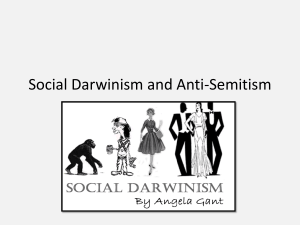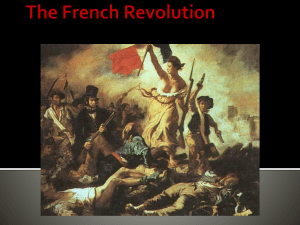Industrialization, Imperialism and Social Darwinism
advertisement

Industrialization and Social Darwinism The Social and Economic Context of Social Darwinism Social Darwinism Defined Social Darwinism is the (mis)application of and (over) extension of Darwin’s theory to explain human society. Social Darwinism uses Darwinian ideas like “evolution”, “fitness”, “struggle for survival” to “explain” and “justify” human inequalities in wealth and power. Types of Social Darwinism 1. Individualistic Social Darwinism 2. Collectivistic Social Darwinism 1. Individualistic Social Darwinism: (a) misuse of “struggle” and “struggle for survival”. Individualistic social Darwinism claims that human society, like nature, is involved in a constant “struggle for survival” between individuals in society. The individuals may be businessmen competing (“struggling”) against other business men for profits and economic “survival”. The individuals may also be individual workers seeking to “survive” by competing (“struggling”) to get hired, earning wages, promotions, etc… 1. Individualistic Social Darwinism (b) misuse of “fitness”, “survival of the fittest” and “evolution” As in Darwin’s theory, the “struggle for survival” assures that only the “fit” survive (“survival of the fittest”) Social Darwinists claim the continuous selection of fitter (human) individuals, drives “social evolution”. Individualistic social Darwinists also claim that “social evolution” tends toward the overall “good” of the human race. 1. Individualistic Social Darwinism (c) consequences for social policy If “social evolution” is for the overall good of society, and if it is driven by continuing “struggle”, then: nothing should be done to reduce the intensity of the “struggle for survival”. Thus, laws or government policies benefiting the poor (“the unfit”) should be reduced or eliminated. 1. Individualistic Social Darwinism: (d) Key role of Herbert Spencer One of the “founders” of Social Darwinism was: Spencer coined the terms “survival of the fittest” and “struggle for survival” even before Darwin published Origin. If they [all people] are sufficiently complete to live, they do live and it is well they should live. If they are not sufficiently complete, they die, and it is well they should die. - Herbert Spencer, Social Statics Herbert Spencer (1820-1903) Individualistic Social Darwinism: William Graham Sumner In the USA, William Graham Sumner (1840-1910), an admirer of Spencer, echoed the same views: “The millionaires are a product of natural selection…” 1. Individualistic Social Darwinism (e) connection to economic liberalism Spencer and Sumner were also supporters of economic liberalism. This idea dates back to Adam Smith (1723-1790) who argued in his famous Wealth of Nations (1776) against government regulations and monopolies typical of the preindustrial era. In many ways Adam Smith was the intellectual father of modern industrial capitalism. 1. Individualistic Social Darwinism (f) connection to laissez-faire Laissez-faire, like economic liberalism, opposed government interference in the economy (no taxes, laws and regulations). Such measures would hinder individual freedom and economic competition, the engine of economic growth (and thus, supposedly, improved conditions for all). 1. Individualistic Social Darwinism: (g) connection to “self-help” idea. Laissez-faire was also seen as a kind of “self-help” and as such, was the best way to ensure the development of individual freedom and responsibility 1. Individualistic Social Darwinism: (g) connection to “self-help” idea. Samuel Smiles, one of the most famous proponents of laissezfaire and “self-help”, put it this way in 1859: 'Whatever is done for men or classes, to a certain extent takes away the stimulus and necessity of doing for themselves; and where men are subjected to over-guidance and over-government, the inevitable tendency is to render them comparatively helpless.' 1. Individualistic Social Darwinism Thus individualistic social Darwinism fit well into the already existing ideas of economic liberalism, laissez-faire and self-help. individuals are responsible for their own lives and should not look to anyone else to take care of any of their needs. The publication of Origin of Species by Darwin in 1859 reinforced the same viewpoint and gave them a supposedly scientific basis. 2. The Industrial Revolution 2. The Industrial Revolution Britain in the 19th century underwent the Industrial Revolution, one of the most important historical events in history. The Industrial Revolution transformed Britain from a rural, agricultural, land-based society to an urban, industrial society. Wealth was now based on the ownership of capital (factories, production) and money rather than on land. 2. The Industrial Revolution: Social Consequences Most did not share in this growth of wealth In the rapidly growing cities, slums developed where poverty, disease, filth, and oppression were a fact of daily life. Gustav Dore “Slum Neigbourhood” (1872) 2. The Industrial Revolution: Social Consequences Gustav Dore, “Over London by Rail” (1872) 2. The Industrial Revolution: Social Consequences Early in the 19th century, no laws provided for maximum working hours, minimum wage, holidays, health and safety, unemployment or sickness insurance, pensions or child labour. Child labour during the Industrial Revolution 2. The Industrial Revolution: Social Consequences Bicycle factory – USA early 20th century Child labour during the Industrial Revolution The Industrial Revolution: Social Consequences Hannah Goode: "I work at Mr. Wilson's mill. I think the youngest child is about 7. I daresay there are 20 under 9 years. It is about half past five by our clock at home when we go in....We come out at seven by the mill. We never stop to take our meals, except at dinner. Evidence of Textile Workers in Wilson's Mill, Nottingham: Source; Factory Inquiry Commission, Great Britain, Parliamentary Papers, 1833. Found in Hellerstein, Hume & Offen, Victorian Women: A Documentary Accounts of Women's Lives in Nineteenth-Century England, France and the United States, Stanford University Press The Industrial Revolution: Social Consequences Hannah Goode: “William Crookes is overlooker in our room. He is cross-tempered sometimes. He does not beat me; he beats the little children if they do not do their work right....I have sometimes seen the little children drop asleep or so, but not lately. If they are catched asleep they get the strap. They are always very tired at night....I can read a little; I can't write. I used to go to school before I went to the mill; I have since I am sixteen." Evidence of Textile Workers in Wilson's Mill, Nottingham: Source; Factory Inquiry Commission, Great Britain, Parliamentary Papers, 1833. Found in Hellerstein, Hume & Offen, Victorian Women: A Documentary Accounts of Women's Lives in Nineteenth-Century England, France and the United States, Stanford University Press The Industrial Revolution: Social Consequences Girl dragging coal tub up a mine shaft The Industrial Revolution: Social Consequences Famous “Girl in Factory” photograph. Early 20th century, USA The Industrial Revolution: Social Consequences Punch magazine cartoon “Capital and Labor” 2. The Industrial Revolution: Social Consequences Street children The Industrial Revolution: Social Consequences In conclusion, I think it has been clearly proved that children have been worked a most unreasonable and cruel length of time daily, and that even adults have been excepted to do a certain quantity of labour which scarcely any human being is able to endure… no child under fourteen years of age should work in a factory of any description for more than eight hours a day. From fourteen upwards I would recommend that no individual should, under circumstances, work more than twelve hours a day; although if practicable, as a physician, I would prefer the limitation of ten hours… Testimony by a Commission of Medical Examiners from northeastern England made to the Parliamentary Commission for inquiry in the Employment of Children in factories, 1833 Imperialism The Quest for Empire and World Domination in the 19th century Imperialism Imperialism= quest for empire Empire = the economic, political or cultural control of one state over other states or cultures. Imperialism By the end of the 19th century, the European powers had expanded their control over most of the world – this was the age of Empire or Imperialism. This was a process that had begun in the early modern period with the voyages of discovery. Imperialism British Empire and Commonwealth Before 1914 Imperialism Imperialism in Africa. Even small countries like Belgium held sizable possession. Imperialism Imperialism lead to racist types of ideologies, such as depicted in this cartoon from a Detroit newspaper in 1899. The idea expressed is that the white man is forcibly “civilizing” the “savage” and thus that imperialism is a noble cause. Imperialism In Britain, famous imperialists like Kipling (original author of The Jungle Book adapted by Disney) claimed Europeans had a “civilizing mission”. Bibliography Dore, Gustav Images from various websites Engels, Friedrich. The Condition of the Working Class in England 1844. Panther: London, 1969. Hellerstein, Erna, L. Hume & K.M. Offen, Victorian Women: A Documentary Accounts of Women's Lives in Nineteenth-Century England, France and the United States, Stanford University Press. Hobsbawm, Eric J. Industry and Empire, Penguin Books: Harmondsworth, 1999 Hofstadter, Richard Social Darwinism in American Thought. Beacon Press: Philadelphia, 1992 Kipling, Rudyard, “The White Man’s Burden” (originally published 1899) Parliamentary Commission for inquiry in the Employment of Children in factories, 1833. Smiles, Samuel Self-Help (originally published 1859) Smith, Adam The Wealth of Nations (originally published 1776) The End










